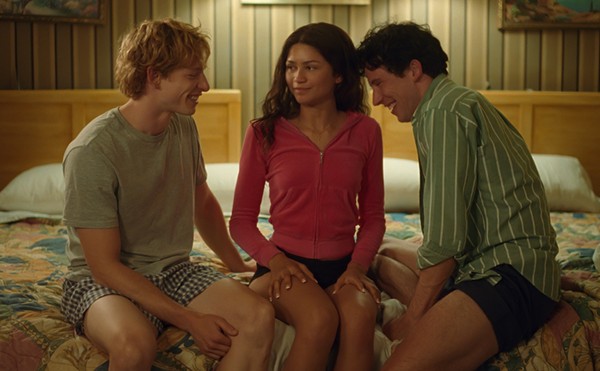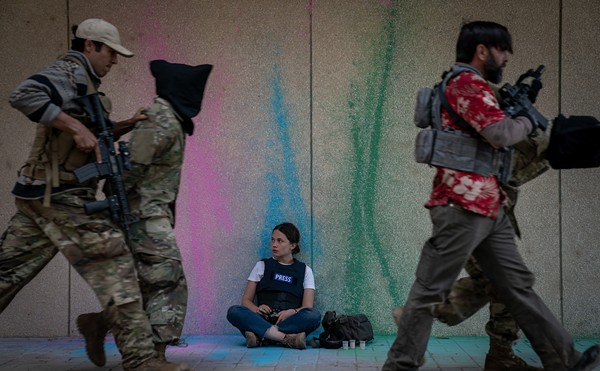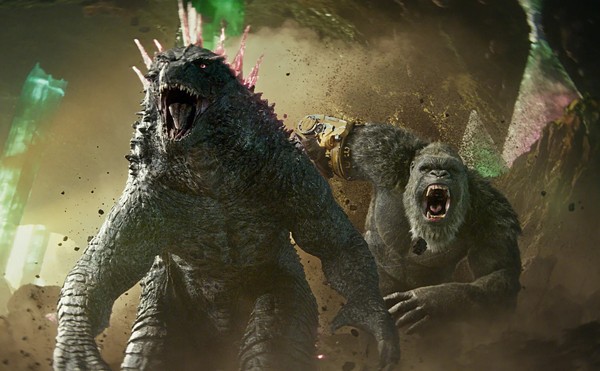Directed by Gus Van Sant
"My films went from being failures to masterpieces without ever being successes," Alfred Hitchcock once moaned, referring to the hostile critical reception that greeted Psycho in 1960. Dwight Macdonald, the dean of middlebrow critics, dismissed it in Esquire as "third-rate," whereas Andrew Sarris, who reviewed the film in his initial appearance in the Village Voice, has recalled that his positive remarks generated the most hate mail he's ever received, with indignant readers asking how a sophisticated publication like the Voice could even waste space on such a low, lurid piece of trash. It's a good illustration of just how much Sarris and his auteurist compatriots changed critical taste that the same film that was savaged nearly 40 years ago is now considered a classic by academics and the public alike, and that the announcement that director Gus Van Sant was contemplating a remake was almost immediately dismissed as a crassly commercial act of desecration.
Van Sant is hardly the first filmmaker to fall under Psycho's spell, but earlier attempts have either used it for inspiration (Brian De Palma's Sisters and Dressed to Kill) or shamelessly cashed in on its name (the weak sequels produced in the '80s).What could a 1998 version add? Color? Digital effects? Graphic sex and violence? Hitchcock's film was made cheaply, in black-and-white, using crew members from his television show, but it was also a conscious break from the lush look of his films of the '50s. He knew that he was testing the limits in sex and violence (he once said that he shot the film in black-and-white because he knew that the blood of the shower scene would never be permitted in a color film), but that was part of the challenge of filmmaking that he most enjoyed.
One thing that no new film can duplicate is the sheer shock value of Hitchcock's film, especially on its first release, when ads warned that "No one ... BUT NO ONE ... will be admitted to the theatre after the start of each performance." ("Please don't give away the ending," they added. "It's the only one we have.") The death of Marion Crane, the apparent heroine, midway through the film was a brilliant and daring act of sheer audience manipulation that few filmmakers have dared to duplicate (De Palma pulled it off, and it was probably the inspiration for the Drew Barrymore cameo in Scream). Few audiences have ever had the opportunity to approach the film with such innocence. (I saw Psycho for the first time when it debuted on TV in 1967, and even then I already knew about the shower scene; the ending, on the other hand, was probably the biggest shock I had ever experienced in my young movie-watching life.)
Why would anyone want to remake Psycho? More specifically, why would anyone want to remake Psycho like this? Using Joseph Stefano's original script, Bernard Herrmann's score and even Saul Bass' title design, Van Sant has executed not just a remake but a scene-for-scene, shot-for-shot, note-for-note re-creation. Virtually every camera angle, every piece of dialogue and every gesture has been duplicated, from the opening shot of the Phoenix skyline to the closing image of Marion Crane's car being dragged from a lake. The differences between the two films are so few and insignificant that they're barely worth noting (the title card giving the date and location of the opening scene now includes the year; the shower scene and the murder of Arbogast have nearly subliminal insert shots; Norman masturbates while spying on Marion through his peephole; the book that Vera Miles threw down with a shudder in Norman's room is now revealed to be a porno magazine), and none could be considered serious alterations or improvements to Hitchcock's film. This Psycho pushes the idea of a remake to absurd limits and raises -- but doesn't answer -- a few unusual questions about the nature of film authorship. Is this an hommage, or is it plagiarism? Can the work of a film director be duplicated like that of a choreographer, even after the filmmaker's death? Is this Gus Van Sant's Psycho, or is it still Alfred Hitchcock's?
Appropriation of earlier works has become a common technique in contemporary art, from rap artists sampling musical tracks from older records to Kathy Acker's practice of lifting paragraphs from other authors in her novels. Pop artists like Warhol appropriated the images of advertising and marketing and turned them into symbols of a consumer culture. In a famous short story, Jorge Luis Borges suggested that a contemporary author could make a classic like Don Quixote his own work, even if the two texts were completely identical. In practice, however, Psycho achieves an opposite effect. This Psycho, meticulous as it is in most respects, is a film without a director, and the blind duplication of every detail of the original actually removes much of what made it work in the first place. When Hitchcock has Marion stopped by a highway policeman, the officer's mirrored sunglasses and aggressive presence add to her discomfort and reflect --literally! -- the voyeurism that runs throughout the film. When Van Sant repeats these details, they lose that meaning. Their only significance is that Hitchcock used them, so they have to be reproduced. Van Sant removes himself but can't really conjure up Hitchcock, either. The most he can hope for is the cinematic equivalent of such roadside attractions as a full-scale model of Notre Dame made out of toothpicks. The details may be right, but it's still a far cry from a cathedral.
This is not to say that the new Psycho is a complete failure, but its finest moments are simply those built-in from the original. The shower scene remains shocking, and the pools of blood that Norman cleans up are intensified by the addition of color, just as Hitchcock suspected. (The color also limits the resonance of Bernard Herrmann's superb score, where the limited register of the strings was designed to complement the film's stark black-and-white tones.) Images that Hitchcock created through clumsy optical effects, like the famous superimposition of Norman's face over that of his decomposed mother, have been rendered by smoother digital effects. The performers try in various degrees to break free from the models of their predecessors, with uneven results. William H. Macy appears to treat his role as Arbogast as some sort of parody of a hard-boiled detective, whereas Vince Vaughn is ultimately trapped by the tics and mannerisms of Anthony Perkins. Similarly, Anne Heche makes an attractive Marion, but the inevitability of her death at midpoint makes it difficult for her to establish her personality. Chad Everett and Robert Forster have more success in small roles, and Viggo Mortensen and Julianne Moore make their characters livelier than expected (possibly because their 1960 counterparts, John Gavin and Vera Miles, were the dullest things in Hitchcock's film).
For what audience is this bizarre mirror-image Psycho intended? In publicity statements, the producers of the new film stress their admiration of the film, respectfully cite it as a timeless, ever-popular classic, and then contradictorily suggest that their film is aimed at a new generation of moviegoers who haven't seen Hitchcock's work. But why duplicate the earlier film frame by frame? And why eliminate its most distinctive feature, its perverse sense of humor? Those in the audience who recognize what Van Sant is doing will inevitably be disappointed, and those who don't know their Hitchcock may not get it at all. Though announced as an act of tribute to the late master, this new Psycho is intended for people who haven't seen the original and probably never will. Simultaneously ambitious and pointless, this new Psycho is an elaborate and even courageous experiment, but one that need not be repeated.





